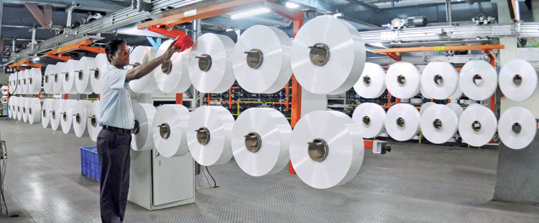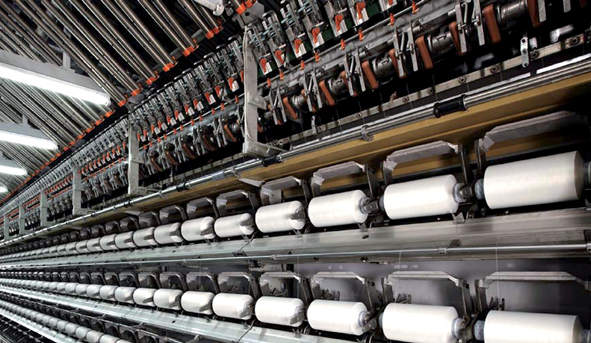 Since inception, Indo Rama has played a pivotal role in widening and enriching the polyester market on the strength of its technological proficiency and cost competitiveness. India’s largest dedicated polyester manufacturer with an integrated complex at Butibori near Nagpur with an annual capacity of 6,10,050 tonnes comprising polyester stable fibre (PSF), filament yarn, draw texturised yarn, fully drawn yarn and textile grade chips, Indo Rama is currently focusing on cost rationalisation and market consolidation. To strengthen its market position and enhance customer satisfaction, the company has introduced several value-added variants of POY, FDY and DTY products.
Since inception, Indo Rama has played a pivotal role in widening and enriching the polyester market on the strength of its technological proficiency and cost competitiveness. India’s largest dedicated polyester manufacturer with an integrated complex at Butibori near Nagpur with an annual capacity of 6,10,050 tonnes comprising polyester stable fibre (PSF), filament yarn, draw texturised yarn, fully drawn yarn and textile grade chips, Indo Rama is currently focusing on cost rationalisation and market consolidation. To strengthen its market position and enhance customer satisfaction, the company has introduced several value-added variants of POY, FDY and DTY products.
In 2011-12, Indo Rama achieved a turnover of Rs. 2,943.27 crores, an escalation of only 5.26 per cent over 2010-11, owing to moderate polyester demand. The company reported net profit of Rs. 31.96 crores against Rs. 139.41 crores in 2010-11. Exports grew from Rs. 805 crores in 2010-11 to Rs. 909 crores in 2011-12, contributing 28.79 per cent of the company’s net sales in 2010-11 and 30.88 per cent in 2011-12. The growth was on account of growing global footprints and foray into unexplored markets.
 In 2011-12, Indo Rama further strengthened its competitive capabilities to deliver more consistent growth. Going ahead, the company’s priorities will be commissioning of a PSF recycle plant to reduce wastage and enhance productivity, hiking PSF production to improve performance of fine denier products and increasing DTY production capacity by addition of new generation machines.
In 2011-12, Indo Rama further strengthened its competitive capabilities to deliver more consistent growth. Going ahead, the company’s priorities will be commissioning of a PSF recycle plant to reduce wastage and enhance productivity, hiking PSF production to improve performance of fine denier products and increasing DTY production capacity by addition of new generation machines.
As a strategic move for its further growth, Indo Rama Synthetics (India) has signed an MoU with the Thailand-based Indorama Ventures to set up a world-class integrated facility in India to produce purified terephthalic acid (PTA), polyethylene terephthalate (PET) and polyester staple fiber (PSF). With an investment of nearly Rs. 4,000 crores, the plant will have an annual capacity of 1.2 million tonnes of PTA, 0.42 million tonnes of PET and 0.21 million tonnes of PSF. On commissioning, the plant will aid Indo Rama’s backward integration, serve Indian customers and expand the group’s global presence.
Indo Rama is expanding the production capacity for value-added draw texturized yarn (DTY) from 64,800 tonnes to 98,145 tonnes by mid-2012 with a cumulative installati on of 56 machines. Currently, the company is running 48 machines. Moreover, it has installed new generation DTY machines to facilitate improved productivity and efficiency. DTY is a value-added product suitable for fabric end uses like garments, skin-clinging garments, furnishings and upholstery, among others. This is a replacement of cotton and cotton blend yarns with very low moisture content.
on of 56 machines. Currently, the company is running 48 machines. Moreover, it has installed new generation DTY machines to facilitate improved productivity and efficiency. DTY is a value-added product suitable for fabric end uses like garments, skin-clinging garments, furnishings and upholstery, among others. This is a replacement of cotton and cotton blend yarns with very low moisture content.
New POY, FDY products
The company has developed new POY and FDY products to enhance customer satisfaction and drive margins. The development of new DTY stretch yarn products (220/144 IM) is most suited for weft application in denim. Another product (65/34 NIM) enjoys application in knitting. These products will expand the company’s capabilities to cater to the premium market segment.
Indo Rama has also introduced a new PSF product (1.2 Den Spunlace) to cater both to domestic and international markets for production of hygienic non-woven items. This has enriched the company’s product basket with an increased market share.
PSF has emerged the fastest growing fibre among the lot. Polyesters are made by polymerisation of PTA and mono ethylene glycol (MEG). The polymer thus obtained is melt spun, and the bundle of continuous filaments obtained by melt spinning is called tow. The tow is subjected to further processes such as drawing, crimping and spin finish application and then cut into fixed lengths to get cut fibres almost equal in length to cotton fibres. These cut fibres are known as PSF.
Partially oriented yarn
Polymer in the melted form from the polycondensation section is cooled in the polymer cooler, filtered and, after pressure boosting, it is distributed to the spinning manifolds and then to the spinning positions. The polyester melt from the spinning position is extruded through spinnerets by variable speed driven spinning pumps. The extruded filaments are cooled by precisely controlled conditioned and filtered air in the quench chamber. The filaments are then passed through the finish application system. They are taken on take-up winders and finally wound on bobbins. The yarn produced is extremely fine and the unit of fineness is denier. The spinnerets and spinning manifold are jacketed and heated with dowtherm vapour.
A major advantage of POY is that, with strict quality control of denier orientation and spread, along with computer-controlled draw force testing, it ensures maximum consistency in yarn performance during and after texturizing. A special proprietary spin finish protects the colour and lubricity of the yarn over long periods of storage.
Fully drawn yarn
Fully drawn yarn (FDY) is produced by a process similar to POY manufacturing except that the yarn is produced at higher spinning speeds, coupled with intermediate drawing integrated in the process itself. This allows stabilisation through orientation and crystallisation. Intermingled FDY yarns are suitable for direct twisting, warping and weaving less waste and high efficiency in subsequent processes due to higher package weight (10 kg). The fabric made from these yarns has a feel and drape similar to fabrics produced from pure silk.
These yarns eliminate draw-twisting and sizing process, reducing the product cost for light and medium range of fabrics. There are low breakages in warping owing to excellent package quality produced on craft winder excellent dyeing consistency.
Draw texturised yarn
Draw texturised yarn (DTY) is a fully drawn, fully-oriented polyester multifilament yarn with soft crimp, high bulk and texture with cotton feel and very high durability and retention properties. This is manufactured by texturizing partially oriented yarn using texturising machines. DTY is produced on the latest high-speed draw texturising machines with identical capability.
Total quality checks are done with respect to dyeability. Bulk and elongation is closely monitored for consistency on captive weaving installations. Electronic package-size measuring units ensure uniform texturised yarn package.
A consistent level of high quality anti-static lubricating oils, together with an option of incorporating adequate interlacement, is applied for purposes of warping without sizing.
In 2011, the global fibre production is estimated to have grown by 7.9 per cent to around 77 million tonnes. The natural fibre accounted for 28 million tonnes, while man-made fibre accounted for 48.7 million tonnes. However, global consumption grew by just one per cent to 81 million tonnes.
The natural fibre accounted for 30 million tonnes consumption, with cotton leading the way with 23.13 million tonnes, and man-made fibres accounted for 50 million tonnes. Natural fibre consumption is expected to decline by 1.9 per cent, synthetic fibre consumption to grow by 2.8 per cent and cellulosic fibre consumption is expected to increase by 4.2 per cent.
The combined cotton and polyester fibre production accounts for 86 per cent of global fibre production. Global per capita consumption of all textile fibres stood at 12 kg.
